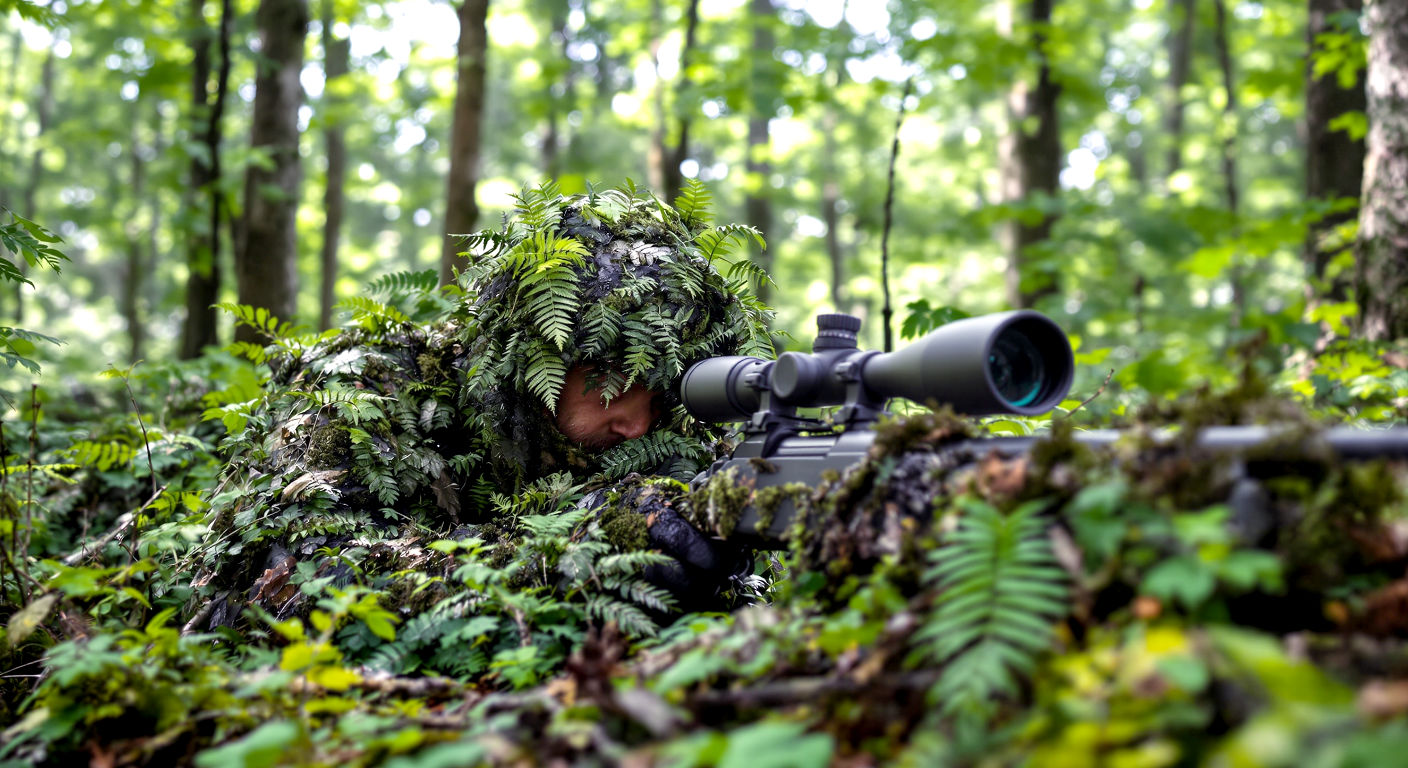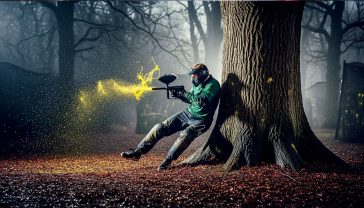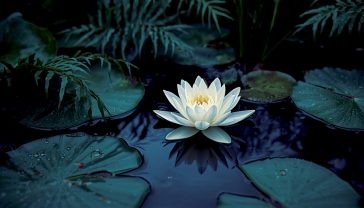The Art of Invisibility: A Hunter’s Guide to Ghillie Suits
Discover the art of the ghillie suit. From its Scottish origins to modern military use, this guide covers how to choose, build, and use one in the British countryside.

This post may contain affiliate links. If you make a purchase through these links, we may earn a commission at no additional cost to you.
Ever felt like you could just disappear? Not in a puff of smoke, but by melting right into the landscape around you. Imagine lying dead still in a field, so perfectly hidden that a deer wanders past without a second glance, or a fox trots by, completely unaware of your presence. This isn’t magic; it’s the art of the ghillie suit, a strange-looking outfit that’s part camouflage, part wearable hedge.
For hunters, wildlife photographers, and even soldiers, the ghillie suit is the ultimate tool for becoming one with nature. It’s more than just a costume covered in leaves and string; it’s a carefully crafted piece of gear that breaks up the human shape, turning a person into just another bump on the log, another clump of grass in the meadow. But where did this bizarre invention come from? Its story starts not in a modern army barracks, but in the misty hills of the Scottish Highlands, with a group of men who needed to be invisible long before it was a military tactic. This guide will take you through the fascinating world of the ghillie suit, from its humble beginnings to how you can choose, make, and use one yourself to truly master the art of invisibility.
What Exactly Is a Ghillie Suit?
At its simplest, a ghillie suit is a type of camouflage clothing designed to break up a person’s outline and help them blend into their natural surroundings. Unlike standard camouflage patterns, which use colours and shapes printed on fabric, a ghillie suit uses a three-dimensional approach. It’s typically a base garment—like a jacket and trousers or a full-body net—covered in strips of hessian, burlap, twine, or other materials. These dangly bits are then customised with local vegetation, like twigs, leaves, and grass, to perfectly match the environment you’re in.
The name itself gives a clue to its origins. “Ghillie” comes from the Scottish Gaelic word gille, meaning a lad or servant. In the Scottish Highlands, ghillies were (and still are) assistants on hunting or fishing expeditions. Their job was to know the land inside out, to track game, and to remain unseen. The suit they developed was born out of pure necessity.
How It Works: Breaking the Human Form
The real genius of a ghillie suit isn’t just about matching colours. Our brains are incredibly good at spotting patterns, and the human shape—with its distinct head, shoulders, and straight lines of the torso and limbs—is one of the most recognisable silhouettes in nature. Even if you’re wearing camouflage clothing, that shape can still give you away.
A ghillie suit works by completely destroying that silhouette.
- Breaking Up the Outline: The loose, shaggy material, jute strings, and added vegetation blur the hard edges of the human body. The head and shoulders disappear into a formless mound. The straight lines of your arms and legs are lost in the chaotic texture. You no longer look like a person.
- Mimicking Natural Textures: The 3D elements of the suit create depth, shadows, and textures that look like the forest floor, a grassy field, or a dense thicket. It doesn’t just copy the colours of nature; it copies the feel of it.
- Blending with the Environment: By adding local flora directly to the suit, you create the most effective camouflage possible. You’re not just wearing a picture of the forest; you’re wearing the forest itself. This process is known as “vegging up.”
Think of it this way: standard camouflage is like a painting of a bush. A ghillie suit is like wearing an actual bush. For an animal whose survival depends on spotting anything out of the ordinary, the difference is night and day.
The Scottish Origins: From Gamekeepers to Ghosts of the Trenches
The story of the ghillie suit begins not on the battlefield, but on the vast, windswept estates of 19th-century Scotland. Landowners employed gamekeepers, or ghillies, to manage deer populations and protect their land from poachers. These early ghillies were masters of fieldcraft. They knew that to get close to the incredibly wary Highland red deer, they needed more than just patience; they needed to become invisible.
They began experimenting, creating rough garments from old sacks and nets, weaving in strips of cloth, moss, and ferns. The goal was to create something that would allow them to lie on a hillside for hours, completely unnoticed by their quarry. The first ghillie suits were created by Scottish gamekeepers as a practical tool for stalking deer.
The Lovat Scouts and the First World War
The ghillie suit’s leap from the hunting grounds to the battlefield came during the Second Boer War (1899-1902). The British Army, fighting against Boer commandos who were expert marksmen and masters of camouflage, realised they needed a new kind of soldier. They formed a regiment called the Lovat Scouts, raised by the 14th Lord Lovat from Highland ghillies and stalkers. These men brought their fieldcraft skills with them, including their homemade camouflage suits. They became the British Army’s first sniper unit, and their ability to blend into the South African landscape was legendary.
When the First World War began, the Lovat Scouts were formally deployed as the British Army’s first sniper unit. In the static, brutal environment of trench warfare, their skills were invaluable. The snipers would crawl out into No Man’s Land, the deadly strip of ground between the opposing trenches, and lie in wait for hours, sometimes days. Their ghillie suits, adapted for the mud, shell craters, and shattered trees of the Western Front, made them practically invisible. They became phantoms, able to gather intelligence and pick off enemy targets with chilling efficiency. The Germans called them “Gespenster” – ghosts.
The effectiveness of the ghillie suit was proven, and the concept was adopted by military snipers around the world, cementing its place as an essential tool of modern warfare.
Anatomy of a Ghillie Suit: The Different Types and Components
While the basic idea has remained the same for over a century, ghillie suits have evolved. Today, you can find several different types, each suited to different needs and environments. They generally consist of a few key components.
The Base Layer
This is the foundation of the suit. It’s the garment that all the camouflage material is attached to.
- Flight Suit or BDU (Battle Dress Uniform): A popular choice, especially for military-style suits. It’s a one-piece or two-piece garment made of tough, durable fabric. The downside is that it can be very hot and heavy.
- Netting Poncho: A lightweight mesh or netting poncho is a much cooler and more breathable option. The netting provides a perfect base for tying on jute or other materials. This is often the preferred choice for hunters who need to move around more.
- Jacket and Trousers: The most common configuration for commercial suits. It offers full-body coverage and is easier to put on and take off than a one-piece suit.
The Camouflage Material
This is the “skin” of the suit, the part that does the work of breaking up your outline.
- Jute Twine/Burlap: This is the traditional material. Strips of burlap or lengths of jute twine are dyed in earthy colours (browns, greens, greys, tans) and tied to the base layer. Jute is effective, but it’s very heavy, especially when wet, and it’s highly flammable unless treated with a fire retardant.
- Synthetic Thread: Modern ghillie suits often use lightweight, synthetic thread. It doesn’t absorb water, so it stays light, and it’s naturally rot-proof and often fire-retardant. It can be just as effective as jute but is far more practical.
- Laser-Cut Leaves: Some high-end suits use 3D laser-cut synthetic leaves. These look incredibly realistic and provide excellent texture without the weight and hassle of traditional materials.
The Veil and Head Covering
Your head is one of the most recognisable parts of your body. A proper head covering is crucial. This is usually a boonie hat or a hood attached to the jacket, covered in the same material as the rest of the suit. A veil of netting or thread often hangs down over the face to obscure it without blocking your vision.
Rifle Wrap
For a hunter or sniper, a camouflaged rifle is just as important as a camouflaged body. A rifle wrap is a strip of netting covered in the same materials as the suit, which you can wrap around your rifle to break up its long, straight lines.
To Build or to Buy? The Great Ghillie Debate
So, you’ve decided you need a ghillie suit. The next big question is: should you make your own or buy one off the shelf? There are strong arguments for both.
Buying a Ghillie Suit
For most people, buying a pre-made suit is the most practical option.
- Pros: It’s quick, easy, and saves a huge amount of time. Commercial suits are often made from modern, lightweight, fire-retardant materials. There’s a wide variety of styles and patterns to choose from, like woodland, desert, or winter/snow.
- Cons: A good quality suit can be expensive. It won’t be perfectly matched to your specific local environment out of the box; you’ll still need to customise it with local vegetation. Cheaper suits can be of poor quality, with sparse coverage or materials that fall apart easily.
What to look for in a commercial suit:
- Material: Look for lightweight, synthetic, fire-retardant thread.
- Coverage: The material should be dense. If you can see the base layer easily, it’s not going to be very effective.
- Construction: Check for strong stitching and a breathable base layer, preferably with mesh panels for ventilation.
Building Your Own Ghillie Suit
For the purist or the person with a very specific environment in mind, building your own suit is a rewarding project. It’s a rite of passage for many snipers and dedicated hunters.
- Pros: You have complete control over the design, materials, and colour patterns, allowing you to create a suit that perfectly matches your local terrain. It’s often cheaper than buying a high-end suit. There’s a great sense of satisfaction in building your own gear.
- Cons: It takes a very, very long time. A well-made suit can take 40-100 hours of tedious work. You need to source all the materials yourself, including the base garment, netting, jute or thread, and dyes. If you use jute, you absolutely must treat it with a fire retardant.
A Simple Guide to Building Your Own Suit
If you’re determined to make your own, here’s a basic rundown of the process:
- Choose Your Base: Get a sturdy jacket and trousers or a netting poncho.
- Attach the Netting: If your base isn’t already netting, you’ll need to attach it. Use a strong adhesive like Shoe Goo or stitch it on securely. This netting is what you’ll tie your ghillie material to.
- Prepare Your Material: Buy burlap sacks or jute twine. Cut the burlap into strips, then pull the individual threads apart. This is the most time-consuming part.
- Dye the Material: Use fabric dye to create a mix of colours that match your environment. You’ll want a blend of browns, greens, tans, and maybe some grey or black. Don’t make the colours too uniform; variety is key.
- Tie it On: Take small bunches of the thread (5-10 strands) and tie them to the netting using simple overhead knots. Mix up the colours randomly to create a natural, mottled look. Start from the bottom and work your way up. Cover the entire suit, including the headgear.
- Weather It: A brand-new ghillie suit looks too clean. Drag it through the mud, let it sit outside in the rain, and generally abuse it. A worn-in suit looks much more natural.
- Fire-Proof It: This is not optional. Get a fire-retardant spray and soak the entire suit, letting it dry completely. Re-apply it periodically.
Using a Ghillie Suit: The Art of Fieldcraft
Owning a ghillie suit is one thing; using it effectively is another. It’s not a magic cloak of invisibility. It’s a tool that only works when combined with good fieldcraft. Here are the golden rules for using a ghillie suit in the British countryside.
1. Movement is Everything
The moment you move, the illusion is broken. Animal eyes are incredibly sensitive to movement.
- Move Slowly and Deliberately: All your movements should be incredibly slow. Think about how a tortoise moves. When you have to move, do it when the wind blows and rustles the vegetation around you, as this will help mask your motion.
- The Ghillie Crawl: The best way to move is by crawling on your belly, using your elbows and toes to push yourself along. Keep your body as low to the ground as possible.
- Freeze: If you think you’ve been spotted, freeze completely. Don’t even turn your head. Often, an animal will stare for a moment and, seeing no further movement, will decide you’re not a threat and go back to what it was doing.
2. Know Your Environment
A ghillie suit is only effective if it matches its surroundings. A woodland ghillie suit will stick out like a sore thumb in a field of dry, yellow grass.
- Veg Up: Before you head out, spend 15-20 minutes adding fresh, local vegetation to your suit. Use the elastic loops or netting on your suit to tuck in grass, leaves, ferns, and small twigs from the exact area you’ll be in. This is the single most important thing you can do to improve your camouflage.
- Use the Shadows: Always try to stay in the shadows. A dark shape in a sunny spot is much more noticeable than a dark shape in a dark spot. Position yourself with the sun behind you if possible, so any animal looking your way will be looking into the sun.
- Consider the Background: Think about what’s behind you. A solid background, like a thick hedge or a dense bank of ferns, is much better than positioning yourself on the crest of a hill where you’ll be silhouetted against the sky (a mistake known as “skylining”).
3. Patience and Observation
Using a ghillie suit is a waiting game. You need to be comfortable staying still for long periods.
- Get Comfortable: Before you settle in, make sure your position is as comfortable as possible. Clear away any sharp stones or sticks.
- Scan Systematically: When you’re looking for wildlife, don’t just let your eyes wander. Scan the landscape in a systematic way, from left to right, then back again, looking for small signs—the flick of an ear, the twitch of a tail. Use binoculars to scan methodically.
- Be Mindful of Scent and Sound: Camouflage is only about sight. You still need to be aware of the wind direction to prevent your scent from being carried to your target. You also need to be completely silent. Make sure your gear is packed so that nothing rattles or squeaks.
Practical Considerations for the UK
- The British Weather: Jute ghillie suits become incredibly heavy when wet. If you’re hunting in the often-damp British climate, a synthetic suit is a much better choice.
- Ticks and Insects: You’ll be lying in long grass and undergrowth, which is prime tick country. Treat your suit and clothing with permethrin spray and always check yourself thoroughly for ticks after a day out.
- Heat: Even lightweight suits can get very hot, especially in the summer. Make sure you stay hydrated. Some suits have ventilation panels, which can be a lifesaver.
Ghillie Suits Beyond the Hunt
While they were born from hunting and honed in warfare, ghillie suits have found uses in other fields too.
- Wildlife Photography and Filmmaking: For photographers and filmmakers trying to capture intimate, natural behaviour, a ghillie suit is an invaluable tool. It allows them to get incredibly close to shy animals without disturbing them. Nature documentaries owe many of their most stunning shots to a patient camera operator hidden in a ghillie suit.
- Paintball and Airsoft: In the world of recreational combat sports, the ghillie suit is the ultimate accessory for the dedicated sniper role-player, allowing them to create ambushes and remain unseen.
- Conservation: Biologists and conservationists sometimes use ghillie suits to observe and study endangered species without causing them stress or altering their natural behaviour.
The Future of Camouflage: Is the Ghillie Suit Here to Stay?
In an age of thermal imaging and advanced sensors, one might think the humble ghillie suit is becoming obsolete. After all, a shaggy suit won’t hide your heat signature from a thermal scope.
However, the military is already adapting. Modern ghillie suits are now being made with special materials that can help to mask a soldier’s thermal signature, scattering their body heat and making them harder to detect.
But for the civilian hunter or photographer, the ghillie suit’s effectiveness remains undiminished. Animals don’t use thermal imaging. They use the same senses they’ve used for millions of years: sight, sound, and smell. And when it comes to defeating the keen eyesight of an animal, the simple, centuries-old principle of the ghillie suit—breaking up the human form with 3D texture—is as effective today as it was for those first Scottish gamekeepers on a misty Highland hill.
It’s a testament to a brilliantly simple idea. By taking bits of the world around you and wearing them, you can become part of it. You can step outside of the human world and, for a few hours, become an unseen observer, a ghost in the machine of nature. And that is a truly remarkable feeling.
Further Reading
For those interested in exploring further, here are some highly respected resources:
- Bushcraft UK: A cornerstone of the British bushcraft community with extensive forums on fieldcraft and camouflage. (https://www.bushcraftuk.com/)
- The British Deer Society: An excellent resource for understanding deer behaviour, which is key to effective stalking and camouflage. (https://www.bds.org.uk/)
- Stalking Directory: A comprehensive UK-based forum for deer stalkers, with countless threads discussing ghillie suits, rifle camouflage, and fieldcraft techniques. (https://www.thestalkingdirectory.co.uk/)






